| |
10:00
|
0347.
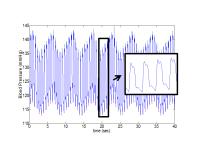 |
Investigating the Effects of 10.5T Static Field Exposure on
Blood Pressure and Heart Rate in Anesthetized Pigs 
Yigitcan Eryaman1, Patrick Zhang1,
Lynn Utecht1, Russell L Lagore1,
Jeramy Kulesa1, Lance DelaBarre1,
Kivanc Kose2, Lynn E. Eberly3, Gregor
Adriany1, Kamil Ugurbil1, and J.
Thomas Vaughan1
1CMRR,Radiology, University of Minnesota,
Minneapolis, MN, United States, 2Dermatology
Service, Memorial Sloan Kettering Cancer Center, New York,
NY, United States, 3Division
of Biostatistics,School of Public Health, University of
Minnesota, Minneapolis, MN, United States
Preliminary studies are conducted to investigate the effects
of 10.5 T whole body exposure on anesthetized pigs. Blood
pressure was measured invasively, recorded and analyzed to
calculate the systolic/diastolic blood pressure levels as
well as the heart rate.
|
| |
10:12
|
0348.
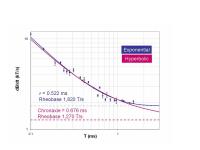 |
Does trans-membrane stimulation occur in peripheral nerve
stimulation: why the SENN does not fit the data? - Permission Withheld
Donald McRobbie1,2
1South Australian Medical Imaging, Flinders
Medical Centre, Adelaide, Australia, 2Surgery,
Imperial College, London, United Kingdom
The Spatial Extended Non-linear Node (SENN) model currently
used in MR safety guidelines does not adequately predict the
behaviour of magnetic stimulation in terms of its time
constant and waveform dependence. This has implications for
the setting of gradient limits in MRI. Stimulation of the
nerve by induced electric fields perpendicular to the nerve
axis may remove the inconsistencies. A better model of
magnetic stimulation is required.
|
| |
10:24
|
0349.
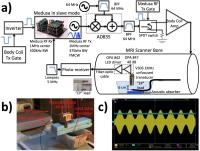 |
Thermo-Acoustic Ultrasound Detection of RF Tip Heating in MRI 
Neerav Dixit1, Pascal Stang2, John
Pauly1, and Greig Scott1
1Electrical Engineering, Stanford University,
Stanford, CA, United States, 2Procyon
Engineering, San Jose, CA, United States
Thermo-acoustic ultrasound uses pressure waves generated by
thermoelastic expansion to measure heating. This technique
can be used to detect excessive local SAR and RF tip heating
in implanted or interventional devices. We compare the
signal quality and inherent properties of several modulation
schemes for thermo-acoustic ultrasound. We then interface a
system for thermo-acoustic detection of heating with an MRI
scanner and demonstrate the first use of thermo-acoustic
ultrasound to detect RF tip heating from an MRI scanner.
|
| |
10:36
|
0350.
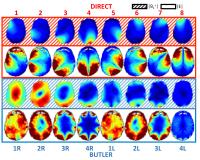 |
Butler matrix transmit channel compression in pTx: a SAR-aware
study. 
Mihir Rajendra Pendse1, Riccardo Stara1,2,3,
Gianluigi Tiberi4, Alessandra Retico2,
Michela Tosetti5, and Brian Rutt1
1Stanford University, Stanford, CA, United
States, 2Istituto
Nazionale di Fisica Nucleare (Pisa), Pisa, Italy, 3Universita'
di Pisa, Pisa, Italy, 4IMAGO7,
Pisa, Italy, 5ISRCC
Stella maris, Calambrone (Pisa), Italy
The use of a Butler matrix in pTx is thought to allow
transmit channel compression by a factor of 2 or more
compared to direct drive, while maintaining similar flip
angle control. However, the SAR-related consequences of this
compression strategy are relatively unexplored. Using a
SAR-aware pTx design method (IMPULSE), we demonstrate that
excellent flip angle uniformity is indeed possible using
only 2 or 4 Butler modes compared to 8 direct drive
channels; however, this comes at the expense of increased
SAR. We also present a generalized strategy for selecting
the optimal subset of Butler modes, i.e. the subset that
provides adequate flip angle control at minimum SAR.
|
| |
10:48
|
0351.
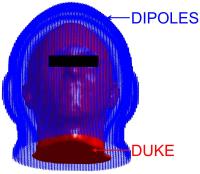 |
Ultimate hyperthermia: Computation of the best achievable
radio-frequency hyperthermia treatments in non-uniform body
models 
Bastien Guerin1,2, Jorge F. Villena3,
Athanasios G. Polimeridis4, Elfar Adalsteinsson5,6,7,
Luca Daniel5, Jacob K. White5, Bruce
R. Rosen1,2,6, and Lawrence L. Wald1,2,6
1A. A. Martinos Center for Biomedical Imaging,
Massachusetts General Hospital, Charlestown, MA, United
States, 2Harvard
Medical School, Boston, MA, United States, 3Cadence
Design Systems, Feldkirchen, Germany, 4Skolkovo
Institute of Science and Technology, Moscow, Russian
Federation, 5Department
of Electrical Engineering and Computer Science,
Massachusetts Institute of Technology, Cambridge, MA, United
States, 6Harvard-MIT
Division of Health Sciences Technology, Cambridge, MA,
United States, 7Institute
for Medical Engineering and Science, Massachusetts Institute
of Technology, Cambridge, MA, United States
We propose a framework for the computation of the ultimate
hyperthermia, which is the best possible hyperthermia
treatment for a given frequency and non-uniform body model
achievable by any multi-channel hyperthermia coil. We
compute the ultimate hyperthermia treatment of two shallow
(close to skull) and deep (close to ventricle) brain tumors
in the realistic “Duke” body model and for treatment
frequencies ranging from 64 MHz to 600 MHz. We characterize
the convergence to the ultimate SAR pattern as well as
temperature increase associated with the ultimate SAR
distribution in the presence of non-uniform perfusion
effects.
|
| |
11:00
 |
0352.
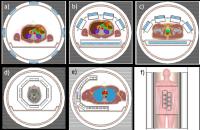 |
A method to approximate maximum local SAR in multi-channel
transmit MR systems without transmit phase information 
Stephan Orzada1, Mark E. Ladd1,2, and
Andreas K. Bitz2
1Erwin L. Hahn Institute, Essen, Germany, 2Medical
Physics in Radiology, German Cancer Research Center (DKFZ),
Heidelberg, Germany
The capability of multi-channel transmit systems to drive
different waveforms in the individual transmit channels
results in an increased complexity for the SAR supervision
In this work we propose a method based on virtual
observation points (VOPs) to derive a conservative upper
bound for the local SAR with a reasonable safety margin
without knowledge of the transmit phases of the channels. In
six different scenarios we demonstrate that the proposed
method can be superior to the simple worst case method often
used when only amplitude and no phase information is
available.
|
| |
11:12
|
0353.
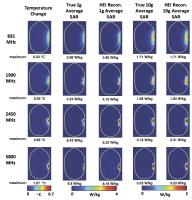 |
Heat Equation Inversion (HEI) Algorithm Sensitivity Assessment
for Computation of SAR from MR Thermometry Acquisitions 
Leeor Alon1,2,3,4, Daniel Sodickson1,2,3,
and Cem M. Deniz1,2,3,4
1Center for Advanced Imaging Innovation and
Research (CAI2R), New York University School of Medicine,
New York, NY, United States, 2Center
for Biomedical Imaging, New York University School of
Medicine, New York, NY, United States, 3NYU
Wireless, NYU-Poly, New York, NY, United States, 4RF
Test Labs, New York, NY, United States
MR thermometry methods are often used to assess safety of RF
antennas. Typically thermal mapping is conducted in
phantoms, which measures the temperature change as result of
exposure to RF waves. From these temperature difference
maps, SAR distribution can be reconstructed using the
inverse heat equation (HEI) framework . With a goal of of
testing the robustness of this method, in this work, we
assessed the fidelity of the algorithm with respect to
different regularization parameter, different SAR
distributions, excitation frequencies and heating durations.
|
| |
11:24
 |
0354.
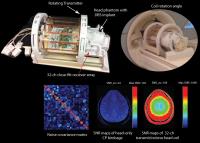 |
A Patient-adjustable MRI coil for implant-friendly imaging of
deep brain stimulation: Design, construction, and
patient-specific numerical simulations 
Laleh Golestanirad1, Boris Keil1,
Maria Ida Iacono2, Giorgio Bonmassar1,
Leonardo M Angelone2, Cristen LaPierre1,
and Lawrence L Wald1
1Radiology, Massachusetts General Hospital,
Charlestown, MA, United States, 2Division
of Biomedical Physics, Office of Science and Engineering
Laboratories, Center for Devices and Radiological Health, US
Food and Drug Administration, Silver Spring, MD, United
States
Recently we presented the feasibility study of using a
reconfigurable DBS-friendly head coil, composed of a
patient-adjustable rotating birdcage transmitter, and an
integrated 32-channel receiver array to reduce SAR during
imaging of patients with deep brain stimulation implants.
Here we introduce the first prototype of such coil system,
and present results of finite element simulations on
patient-derived numerical models of realistic DBS lead
trajectories, which characterize its SAR reduction
performance.
|
| |
11:36
|
0355.
 |
Fast Full-Wave Calculation of Electromagnetic Fields for MRI
Applications Based on Weak-Form Volume Integral Equation (VIE) 
Wan Luo1,2, Shao Ying Huang1, Jiasheng
Su1, Zu-Hui Ma1, and J. Thomas Vaughan3
1Singapore University of Technology and Design,
Singapore, Singapore, 2University
of Electronic Science and Technology of China, Chengdu,
China, People's Republic of, 3University
of Minnesota, Minneapolis, MN, United States
When B0 in
a MRI system increases, peaks and nulls are formed in the
energy/field distribution inside the subject under scan,
which causes safety issues and deteriorates imaging
accuracy, respectively. Therefore, a quick and accurate
electromagnetic simulation of the human body is crucial for
predicting the temperature and specific absorption rate
distribution before a scan. Here, we develop a solver based
on the weak-form volume integral equation (VIE) and
accelerated by the fast Fourier transform method. It
requires much less CPU time and memory compared with the
traditional strong-form VIE and the popular FDTD-based
commercial software SEMCAD.
|
| |
11:48
 |
0356.
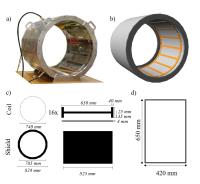 |
Inter-laboratory study of a computational radiofrequency coil
model at 64 MHz 
Elena Lucano1,2, Mikhail Kozlov3,
Eugenia Cabot4, Sara Louie5, Marc
Horner5, Wolfgang Kainz1, Gonzalo G
Mendoza1, Aiping Yao4,6, Earl Zastrow4,6,
Niels Kuster4,6, and Leonardo M Angelone1
1Center for Devices and Radiological Health,
Office of Science and Engineering Laboratories, U.S. Food
and Drug Administration, Silver Spring, MD, United States, 2Department
of Information Engineering, Electronics and
Telecommunications, University of Rome "Sapienza", Rome,
Italy, 3MR:comp
GmbH, Gelsenkirchen, Germany, 4IT'IS
foundation, Zurich, Switzerland, 5ANSYS,
Inc., Canonsburg, PA, United States,6Department
of Information Technology and Electrical Engineering, ETH,
Zurich, Switzerland
Preliminary results of an ongoing inter-laboratory study are
presented. The eventual purpose of the effort is to develop
a methodology that harmonizes RF-modeling and RF-testing
protocol for use in RF exposure assessment. In this phase of
the study, numerical and experimental data were collected
from four laboratories for unloaded and loaded coil
conditions. Only information about the geometry and
resonance frequency of the physical coil was provided.
Qualitatively good agreement across all teams was found.
Subsequent phases of the study shall include a methodology
on uncertainty analysis associated with the numerical and
experimental methods that can be used in practice
|
|









